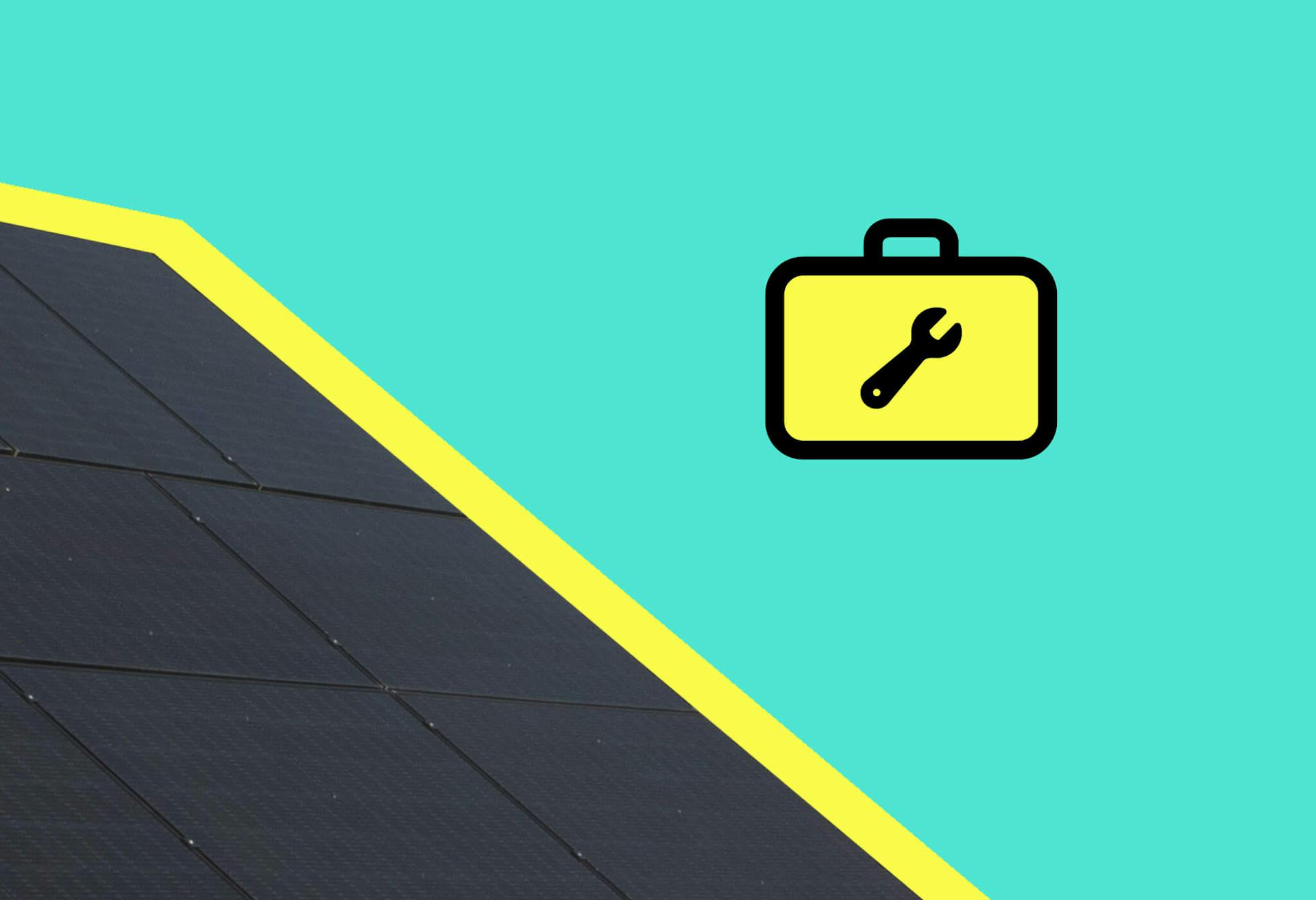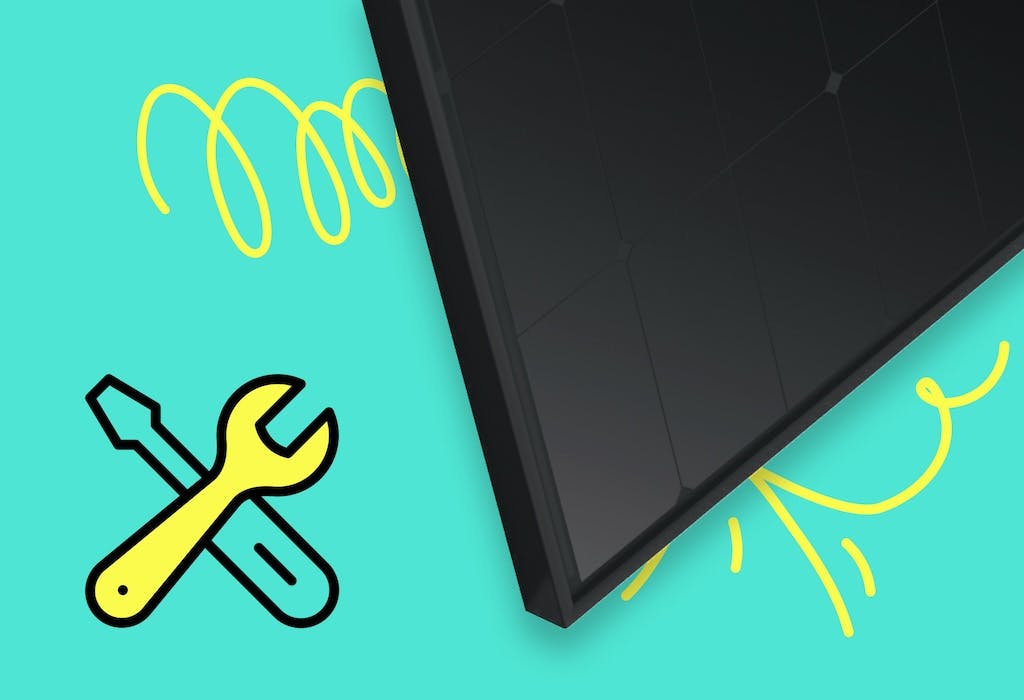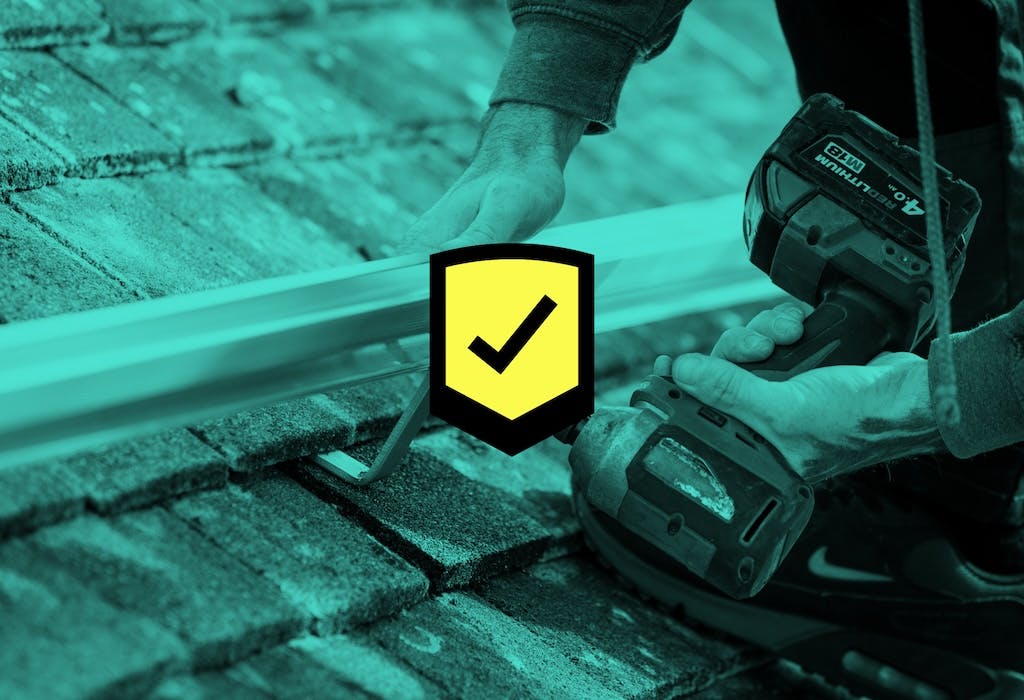- Solar advice hub
- Maintenance
- Solar panel bird proofing: an expert guide
Solar panel bird proofing: an expert guide
Here are all the reasons to bird-proof your solar panels, how much it costs, and whether it's worth it.


Why you can trust our content
We know that the solar industry is full of misinformation, but we only use reliable sources, including:
- Our experienced solar experts, installers and system designers
- Our own database of solar & battery system designs
- Authoritative bodies like MCS and the UK government



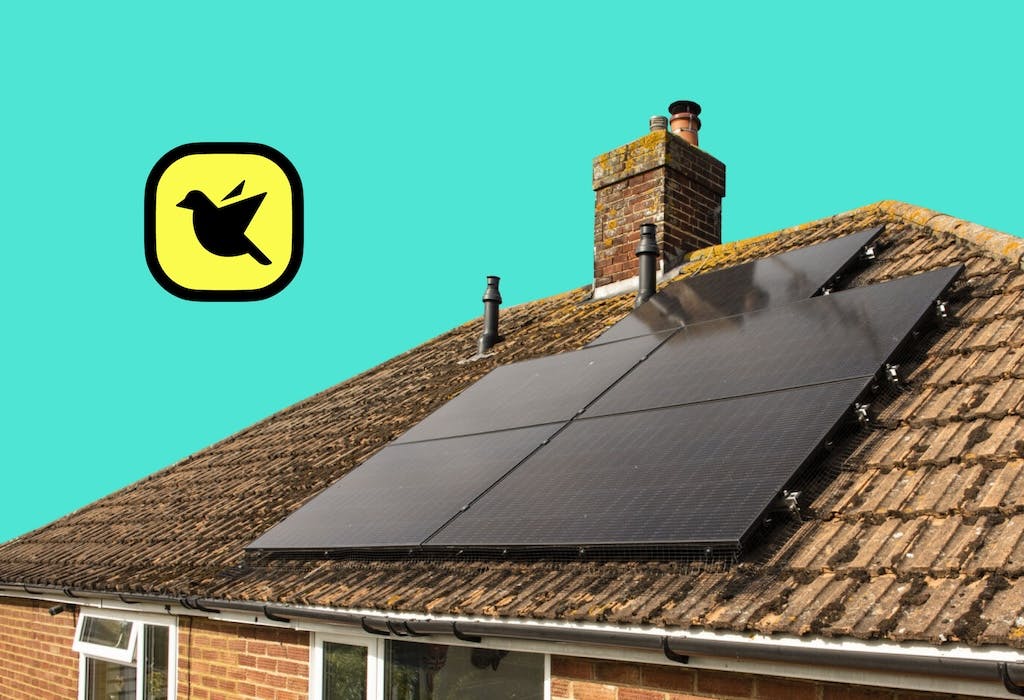
Calculate savings
What kind of home do you live in?
Calculate savings
What kind of home do you live in?
Solar panel bird proofing: at a glance
As much as we love our feathered friends and other local wildlife, they can become an inconvenience for a solar panel system.
The space under solar panels is prime property for animals looking for a safe haven – and if homeowners aren’t careful, they could end up with a set of nuisance neighbours who are difficult to remove.
In this article, we’ll explore what you can do to safeguard your solar panel investment from unwanted visitors – whether they’re birds, squirrels, or something else.
To find out how much a solar & battery system (with bird protection) could save you in the long run, answer a few quick questions below and we'll generate an estimate.
Find out how much you can save
What kind of home do you live in?
Do you need to get bird proofing for your solar panels?
Bird proofing for your solar panels can be a sensible precaution if your area has a lot of birds looking to make a nest.
The UK is home to around 170 million wild birds , including 18 million pigeons who all enjoy nesting under solar panels – which they can then damage with poo and by pecking at the wiring.
And if you've ended up paying the high upfront cost of solar, it makes sense that you want to protect it.
However, bird proofing isn’t vital for all households, because birds don't nest on every domestic roof.
If there are other homes in your neighbourhood with solar panels, we'd recommend asking the occupants whether they've had any bird problems.
If you’re on the fence, we'd advise getting bird proofing during your solar installation, since you'll pay much more to add it on at a later date, as you'll have to pay for scaffolding all over again.
What problems can birds cause under your solar panels?
Birds nesting under solar panels can cause chaos, messing up everything from the panels' output to the surrounding structures. In some cases, the damage can end up being an expensive headache.
Let's look at some of these issues in more detail:
- Hotspots
- Panel corrosion
- Damage to the wiring
- Noise
- Rooftop mess
- Attract other pests
1. Hotspots
Your solar panels’ output is everything. It determines how much money you can save on your energy bills – but it can be significantly diminished by hotspots.
Once birds have nested beneath your panels, they’ll start to poo on top of them, which naturally reduces how much light can get through.
This will increase the affected cells' electrical resistance, causing hotspots, which can melt or burn the cells, damage their electrical parts, or cause cracks in the glass – all of which can permanently damage your system.
In this way, bird poo will have the same effect as permanent shading.
2. Panel corrosion
Birds' urine, which gets excreted at the same time as poo, can corrode your panels.
It contains uric acid, which can wear away the anti-reflective coating and reduce your system's efficiency.
If this happens to your panels, make sure to clean it away relatively quickly, especially during drier months.
3. Damage to the wiring
Nesting birds have a habit of pecking at wiring and other components essential to the functionality of the solar panels, causing damage and reducing their output.
There are a few theories why birds do this, including that wires look like twigs they could break apart to use for their nests, and that a wire's shiny outer coating makes it look like an edible - if strange - beetle.
In any case, it's self-defeating. Birds love the warmth provided by panels, but they don't know that mindlessly breaking some cables could stop this plentiful supply of heat.
4. Noise
If you've ever had the pleasure of being rudely awakened by pigeons at the crack of dawn, you'll understand just how disturbing their noises can be.
Pigeons' calls are generally quiet, but if you sleep directly under your roof, they can still wake you up – particularly during mating season.
Throw in the inevitable sounds of nest-building on the roof above you, and you have a bothersome situation.
Verified expertOne of the worst problems that birds cause when they nest under your solar panels is noise - and I’m talking from experience. They’re particularly prone to making a racket in the early hours of the morning during summer, which makes it very difficult to sleep!
Andrei Stavila
Technical Manager at Sunsave
Andrei has worked in residential solar installation for more than 17 years, and is a fully qualified electrical engineer.
5. Rooftop mess
Birds, like so many animals, are a sloppy bunch. The accumulation of nesting materials and the aforementioned excrement can create an unsightly mess on rooftops.
Regular cleaning is a must, otherwise you'll end up with clogged gutters and drains.
They can also damage your roof tiles, partly through their unfortunate custom of dropping stones on it from a height as they go about building their nests.
And if you already have a broken roof tile, they may peck at it to damage it further, so they can gain entry to your home.
To learn more, check out our guide to solar panel cleaning.
6. Attract other pests
A bird’s cosy nest can attract other pests like squirrels, rats, mice, and insects who want in on the action.
These fellow trespassers can exacerbate damages to both panels and the structure of the building.
This is especially true of squirrels and all other rodents, which will instinctively chew through your panels' wiring to control the length of their teeth.
Some birds, including pigeons and sparrows, also carry mites that can infest your home.
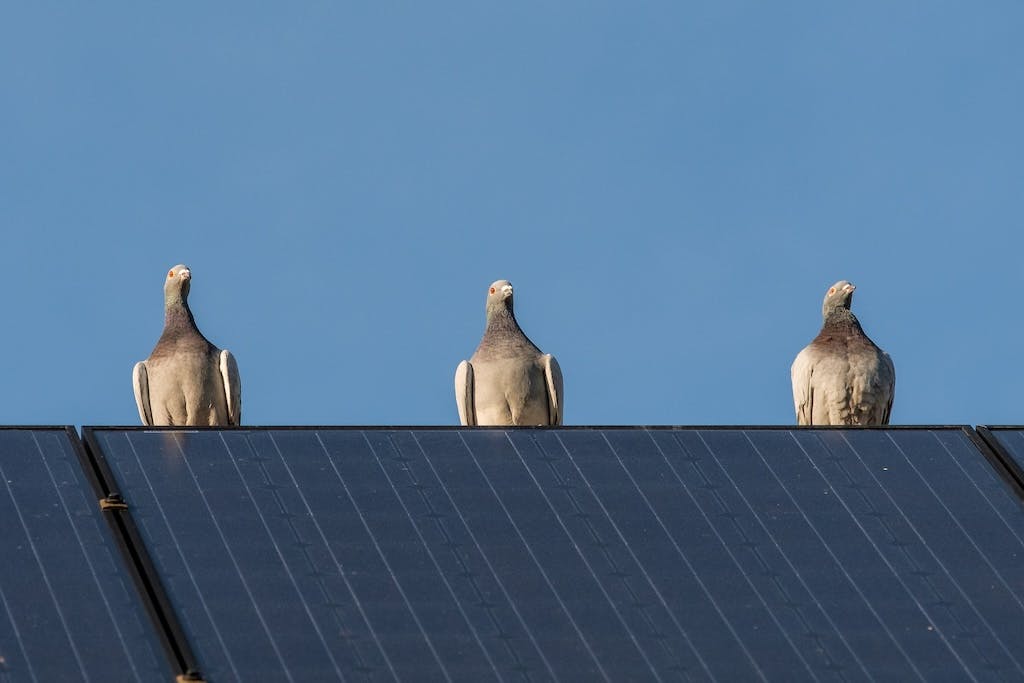
Types of solar panel bird proofing
Solar panel bird proofing usually involves putting physical barriers around the edges of the panels, which prevent birds from nesting underneath them. However, there are a few other strategies.
Common solutions include:
- Installing wire or plastic mesh around the edges of the solar panels to prevent birds from accessing the space underneath
- Placing plastic or stainless steel bird spikes around the solar panels to create an uncomfortable landing surface for birds
- Adding solar ‘skirts’ to the edges of solar panels. These operate in the same way as wire mesh, except they're often the same colour as the panels
- Objects such as reflective tape, scare balloons, or fake predators (like owls or hawks) can be used as visual deterrents to discourage both land- and air-based pests from getting too close
- It's also worth keeping your garden clean and outdoor bins sealed, as this will deter birds (and other critters), and therefore make it less likely they’ll try to nest under your panels
- Acoustic deterrents like ultrasonic devices. Humans usually can’t hear these sounds, but they're designed to repel birds – though there's no evidence they work
How much does solar panel bird proofing cost?
Compared to the overall cost of installing a solar & battery system, bird proofing is relatively inexpensive, at roughly £50 per panel.
| Solar system size | Number of panels (430W) | Rough cost of bird proofing |
|---|---|---|
As you can see, if you were to get a 3-4kWp solar panel system (which is approximately the right size for a three-bedroom property), you’d spend about £350-500 on bird proofing.
However, these costs are in the context of getting bird protection at the same time as your solar installation – if you add protection later on, you’ll have to pay for scaffolding all over again.
Can you add bird proofing to an existing solar panel system?
In most cases you can retrofit bird proofing, but it's usually more cost-effective to do it when you install the solar panels, to make the most of the scaffolding.
What’s more, if birds have already nested under your solar panels before you add bird protection, you may also have to pay for an initial clean-up process.
How long does bird proofing last?
Bird proofing solutions can last as long as your solar panels.
If you get high-quality protection, like metal spikes, and they're installed correctly, they'll almost certainly last the full lifespan of your solar panel system – meaning upwards of 30 years.
However, it depends on the type of bird proofing you choose.
How to remove birds from under your solar panels
If you've already got birds nesting under your solar panels, be careful to avoid breaking the law.
The Wildlife and Countryside Act 1981 means it’s an offence to take, damage, or destroy a wild bird's nest while the nest is in use or being built.
Anyone convicted of such a crime will face a fine with no built-in limits – meaning the amount is left entirely up to the judge – or six months in prison.
You’re free to remove any inactive nests, so once you're absolutely sure the chicks and their parents have left home, feel free to take it away and clean the area thoroughly.
It's always safer to get a professional to carry out this duty, seeing as any roof work can be dangerous.
Are there any other pests that nest under solar panels?
There are other pests aside from birds that are attracted to the shelter, warmth and superior nesting spot that solar panels provide.
Just like their avian counterparts, these animals can cause damage by gnawing on wiring, breaking roof tiles, and leaving their waste everywhere.
Squirrels in particular will gnaw on anything to perform their own DIY dental work, and wires make perfect chew toys.
There have also been cases of hornets and wasps building large nests under solar panels, which can interfere with the ventilation system, since the space between your panels and the roof keeps your system cool.
This can make your system less efficient – not to mention it leads to an increased likelihood of being stung.
Fortunately, high-quality bird protection like spikes should also keep out these animals.
Next steps
Solar panels are an excellent addition to any home in the UK, but it’s important that they don’t become a home for birds in the process. If you’re thinking of getting a solar & battery system for your property, it’s sensible to invest in some sturdy bird protection.
To discover how much a solar & battery system could save you on your energy bills, answer a few quick questions below and we’ll generate an estimate.
Find out how much you can save
What kind of home do you live in?
Solar panel bird proofing: FAQs
Related articles

Written byMelody Abeni
Based in London, Melody is a specialist green technology writer who has been covering sustainability, climate action and ESG for the past five years, after gathering operational experience in green investing and financial services. She has written for various industry publications, including renewable technology advisor The Eco Experts, and she holds a Master’s degree in law from Birkbeck University.




